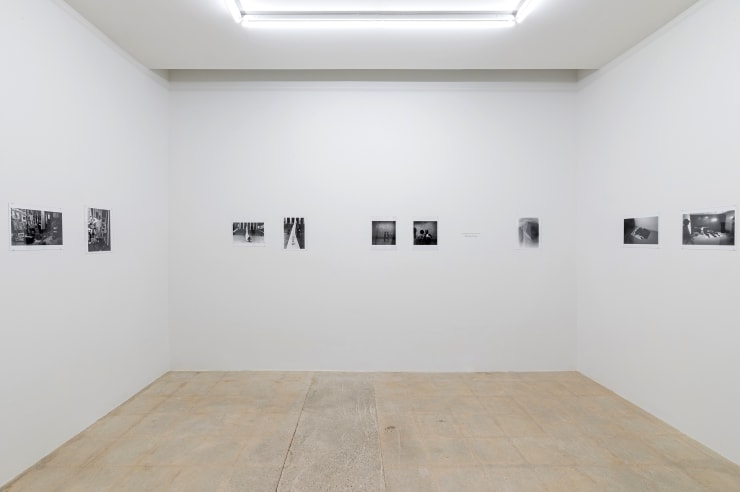Yutaka Matsuzawa
Yutaka Matsuzawa was born February 2, 1922 and grew up in Shimosuwa, Nagano in mountainous central Japan. He studied architecture from 1943–1946 at Waseda University in Tokyo, but gave it up to return home and focus on poetry and art. From 1955 to 1957, he stayed in the United States on a Fulbright Fellowship as well as a Japan Society fellowship, where he studied philosophy and religion at Columbia University in New York.
Matsuzawa developed his own eclectic philosophy of "conceptualism" (what would eventually be known as conceptual art). In its first phase, from 1957–1964, Matsuzawa created surrealist works based on his "Theory of Psi" based on his interpretation of parapsychology. In his second phase from 1964 onward, Matsuzawa reacted against the materialism of his earlier works and installations, and created a new anti-materialist art - art that existed with few or no objects as part of it. Matsuzawa's idea was to encourage viewers to imagine art in their own mind's eye. His new form of art often consisted of absences - for example, a photo with part of it cut out or blanked. He also created "emissions" to be placed in a landscape, such as during his 1964 exhibition "Independent '64 in the Wilderness".
Matsuzawa died on October 15, 2006.
-
 Yutaka MatsuzawaContemplate a White Circle in This White Sheet of Paper (Swan Song) この一枚の白き和紙の中に (白鳥の歌), 1976SilkscreenPaper size: 35 7/16 x 35 7/16 in (90 x 90 cm)
Yutaka MatsuzawaContemplate a White Circle in This White Sheet of Paper (Swan Song) この一枚の白き和紙の中に (白鳥の歌), 1976SilkscreenPaper size: 35 7/16 x 35 7/16 in (90 x 90 cm)
-
 Yutaka MatsuzawaMy Own Death (私の死), 1970Photostat panel35 7/8 x 36 5/8 x 1 1/4 in
Yutaka MatsuzawaMy Own Death (私の死), 1970Photostat panel35 7/8 x 36 5/8 x 1 1/4 in
91 x 93 x 3 cm -
 Yutaka MatsuzawaOn "Meaning of Psi" and Psi Chamber,"〈プサイの意味〉および〈プサイ函・Psi Chamber〉, 1961Print13 x 9 1/2 in (33 x 24 cm)
Yutaka MatsuzawaOn "Meaning of Psi" and Psi Chamber,"〈プサイの意味〉および〈プサイ函・Psi Chamber〉, 1961Print13 x 9 1/2 in (33 x 24 cm) -
 Yutaka MatsuzawaPsi Chamber, 196113-1/4 x 9-1/2 inches
Yutaka MatsuzawaPsi Chamber, 196113-1/4 x 9-1/2 inches -
 Yutaka MatsuzawaPsi Corpse (プサイの死体遺体), 1964/ 19959 sheets; offset lithograph, 2nd printingPaper size: 15 1/8 x 10 1/4 in (38.4 × 26 cm) each
Yutaka MatsuzawaPsi Corpse (プサイの死体遺体), 1964/ 19959 sheets; offset lithograph, 2nd printingPaper size: 15 1/8 x 10 1/4 in (38.4 × 26 cm) each
Framed: 21 1/8 x 16 1/8 in (53.6 x 40.9 cm) each -
 Yutaka MatsuzawaPsi Corpse (プサイの死体遺体), 1964/ 199519 sheets; offset lithograph, 2nd printing15 1/8 x 10 1/4 in
Yutaka MatsuzawaPsi Corpse (プサイの死体遺体), 1964/ 199519 sheets; offset lithograph, 2nd printing15 1/8 x 10 1/4 in
38.4 x 26 cm -
 Yutaka MatsuzawaThe Nine Meditation Chambers (concrete platform)floor
Yutaka MatsuzawaThe Nine Meditation Chambers (concrete platform)floor
installation
with text -
 Yutaka MatsuzawaThe Nine Meditation Chambers (九想の室), 197712 handwritten and typed sheetsPaper size: 7 1/8 x 10 1/8 in (18 x 25.6 cm) each
Yutaka MatsuzawaThe Nine Meditation Chambers (九想の室), 197712 handwritten and typed sheetsPaper size: 7 1/8 x 10 1/8 in (18 x 25.6 cm) each
Framed: 11 x 13 1/2 (27.9 x 34.3 cm) each -
 Yutaka Matsuzawaψ Box (松澤宥 ψの函), 1983Artist’s book, published by Zōkeisha, TokyoBox: 12 x 11 13/16 x 2 1/4 in (30.5 × 30 × 5.5 cm)
Yutaka Matsuzawaψ Box (松澤宥 ψの函), 1983Artist’s book, published by Zōkeisha, TokyoBox: 12 x 11 13/16 x 2 1/4 in (30.5 × 30 × 5.5 cm)
-

Yutaka Matsuzawa
Co-curated by Alan Longino and Reiko Tomii Originated by Yale Union, Portland, Oregon September 7 - October 5, 2019Press: ArtAsiaPacific , Issue 116 Nov/Dec, 2019 Nonaka-Hill is pleased to host an exhibition by Yutaka Matsuzawa (b. 1922; d. 2006, Shimo Suwa, Japan). Known as one of the leading...Read more -

Yutaka Matsuzawa through the lens of Mitsutoshi Hanaga
September 7 - October 5, 2019Nonaka-Hill have organized Yutaka Matsuzawa through the lens of Mitsutoshi Hanaga, a small presentation of the photographer who documented the avant-garde in 1960s Japan, underground and youth culture, and such...Read more











